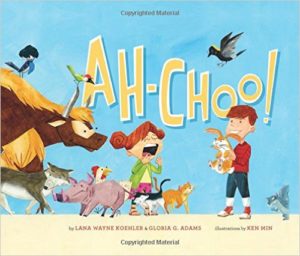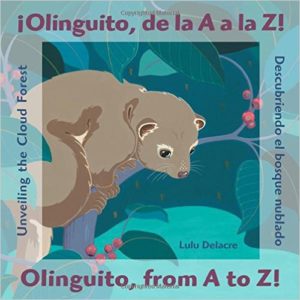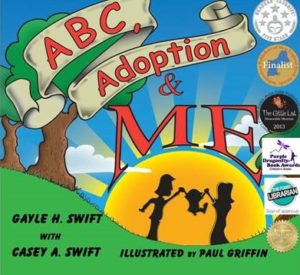 Introducing new information in alphabetical order allows kids to intuitively use this familiar sequence to help them store and retrieve data. It’s a built-in, subconscious organizational system which gives rise to our cultural expression, “easy as ABC.” Whether helping children learn how to care for the earth, explore the variety of our planet’s wildlife, pick up another language, or wrestle with the complexities of adoption, an ABC format eases new learning. This post will review four alphabet books. While they touch on very different topics, each presents information in alphabetical order.
Introducing new information in alphabetical order allows kids to intuitively use this familiar sequence to help them store and retrieve data. It’s a built-in, subconscious organizational system which gives rise to our cultural expression, “easy as ABC.” Whether helping children learn how to care for the earth, explore the variety of our planet’s wildlife, pick up another language, or wrestle with the complexities of adoption, an ABC format eases new learning. This post will review four alphabet books. While they touch on very different topics, each presents information in alphabetical order.
 Compost Stew: An A to Z Recipe for the Earth by Mary Mckenna Siddals and illustrated by Ashley Wolff uses both the ABC format and rhyming which makes the text fun to hear and repeat. Over and over. And over again! The subject matter has natural appeal to kids, who, after all love all things squishy, squirmy and squelchy.
Compost Stew: An A to Z Recipe for the Earth by Mary Mckenna Siddals and illustrated by Ashley Wolff uses both the ABC format and rhyming which makes the text fun to hear and repeat. Over and over. And over again! The subject matter has natural appeal to kids, who, after all love all things squishy, squirmy and squelchy.
Compost Stew carries a vital environmental message and suggests an enjoyable family project. It will open conversations about why recycling is important, what is recyclable and what is not. This will also help raise environmentally aware consumers. (It just might entice some adults to join the recycling movement.) The fabulous collage illustrations serve as a reinforcing metaphor for a successful compost stew, variety and cooperation. And illustrates how the finished product blends the ingredients into a new and better result.
Compost Stew also borrows from the familiar meme of Stone Soup and highlights the benefits of working together to pool resources and efforts. The formula for success is as easy as ABC: cooperation + many ingredients + success.
 Adoption-attuned Lens: Probably the most obvious segue to an adoption-attuned question is to focus on how our families are enriched by the differences (talents, quirks, cultural traditions, etc,) which our children contribute to the family. This book really hammers home–in a good way–the concept of how we vastly enhance things when we blend efforts and diverse elements.
Adoption-attuned Lens: Probably the most obvious segue to an adoption-attuned question is to focus on how our families are enriched by the differences (talents, quirks, cultural traditions, etc,) which our children contribute to the family. This book really hammers home–in a good way–the concept of how we vastly enhance things when we blend efforts and diverse elements.
 Ah-Choo by Lana Wayne Koehler and Gloria G. Adams with illustrations by Ken Min is a raucously entertaining book with several themes. A boy’s yearning for a pet is impeded by his sister’s hyper-sensitive allergy. Brother patiently seeks the perfect pet for their family. Various animals arrive–in alphabetical order. Readers meet some rather exotic beasties. Alas, much to brother’s disappointment, each creature generates a loud ah-choo from Sister.
Ah-Choo by Lana Wayne Koehler and Gloria G. Adams with illustrations by Ken Min is a raucously entertaining book with several themes. A boy’s yearning for a pet is impeded by his sister’s hyper-sensitive allergy. Brother patiently seeks the perfect pet for their family. Various animals arrive–in alphabetical order. Readers meet some rather exotic beasties. Alas, much to brother’s disappointment, each creature generates a loud ah-choo from Sister.
Hilarious illustrations capture the chaos and light-hearted tone of the book which concludes with a happy ending. They finally discover a pet with “no feathers, fur or hair..” Read the book to find out what it is.
 Adoption-attuned Lens: In addition to the jubilant tone created with the rhyming text, this book makes it easy to talk about how the family worked to find a way to incorporate sister’s needs. The search brings the siblings together. Families support one another in this same way. A subtle message of caring leaps from the story; brother doesn’t whine or get angry. He gets creative and everyone benefits in the long run.
Adoption-attuned Lens: In addition to the jubilant tone created with the rhyming text, this book makes it easy to talk about how the family worked to find a way to incorporate sister’s needs. The search brings the siblings together. Families support one another in this same way. A subtle message of caring leaps from the story; brother doesn’t whine or get angry. He gets creative and everyone benefits in the long run.
 Olinguito, from A to Z! uses a more typical ABC format where the featured letter appears in a graphic element of the page spread. The story follows a zoologist as he treks through “a cloud forest….high, high up in the Andes” in search of the “elusive olinguito” (a species of raccoon only discovered in 2003!) Along the way, he observes a delightful array of exotic plant and animal life.
Olinguito, from A to Z! uses a more typical ABC format where the featured letter appears in a graphic element of the page spread. The story follows a zoologist as he treks through “a cloud forest….high, high up in the Andes” in search of the “elusive olinguito” (a species of raccoon only discovered in 2003!) Along the way, he observes a delightful array of exotic plant and animal life.
The back matter includes additional information about the discovery of this new species and the thrill it brought to the scientific community. The illustrator’s commentary describes the process used to create the moody and accurate pictures. He concludes with these words, “I came back from my trip amazed at the interconnectedness among all life forms in the cloud forest. Today I have a deep respect for what these rich places mean to humans and the earth.”
With all that has been in the headlines lately, this message of interdependence and mutual respect is timely. As the title suggests, the text appears in both Spanish and English and is in alphabetical order according to the Spanish word, not the English translation.
 Adoption-attuned Lens: It would be easy to use this book to open conversations about how, like the animals of the cloud forest, families care about and depend on each member. What endangers one, endangers all. While the needs of each will differ, all family members must have their needs met.
Adoption-attuned Lens: It would be easy to use this book to open conversations about how, like the animals of the cloud forest, families care about and depend on each member. What endangers one, endangers all. While the needs of each will differ, all family members must have their needs met.
Families have evolved to include a variety of parent child combinations. Through friends and classmates, children come in contact with families that look different from their own. Sometimes this can confuse or worry them. Kids need information to help them understand whether bio, adoptive, foster or step families–they are more alike than they are different. It’s as easy as ABC: all families are “real.” The unifying factor is that they love and care for one another.
Almost every classroom in America includes some adopted children so this is a topic that interests many children. ABC, Adoption & Me: A Multicultural Picture Book by Gayle H. Swift with Casey A. Swift and illustrated by Paul Griffin explores adoption in a gentle, respectful way. It relies on the familiar scaffold of alphabetical order to structure the book.
At first glance, it seems a basic picture book, yet the concepts are actually significant ones for all adoptive families to explore. By using a cartoon-like illustrations, these ideas can be explored on a light and simple level, or on a nuanced, multi-layered one.
For example, “B is for bellybutton.” All kids have belly button. This universal commonality points out how we are all alike. It also opens the door to a deeper conversation with older children about how a belly button connects a baby to its mother before the baby is born. When appropriate, parents use this page to spark a conversation about birth mothers and fathers.
ABC, Adoption & Me has won numerous awards and helps explain a complex topic to children whether they are adopted or not. It serves adoptive families particularly well and includes a guide to help parents and teachers.


